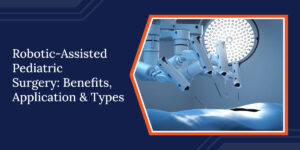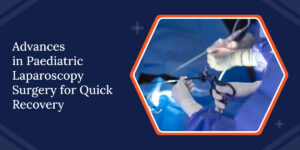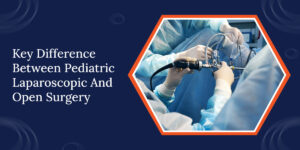 A] Introduction
A] Introduction
Paediatric laparoscopic surgery has transformed the way children undergo surgical procedures. Unlike traditional open surgeries, laparoscopy uses tiny incisions, leading to faster healing and minimal discomfort. This advanced technique is widely used to treat various conditions in children, from hernia repair to complex gastrointestinal issues. Recent advancements, including 3D imaging, robotic assistance, and AI integration, have further improved surgical precision and recovery rates. Parents often worry about surgery for their children, but with modern paediatric laparoscopic procedures, the risks are lower, and the benefits are greater. This blog explores key developments in minimally invasive laparoscopic surgery in paediatric care.
Prioritize Your Child’s Health with Minimally Invasive Surgery – Get Expert Care!
B] What is Paediatric Laparoscopic Surgery?
Paediatric laparoscopic surgery is a minimally invasive surgical technique used to diagnose and treat conditions in children. It involves making small incisions through which a tiny camera (laparoscope) and specialised instruments are inserted. The surgeon views real-time images on a monitor and performs precise procedures without the need for large cuts. Here is a comparison with traditional open surgery:
- Smaller Incisions: Laparoscopic surgery requires only a few millimeters of incision, whereas open surgery involves larger cuts.
- Faster Recovery: Children heal quicker due to reduced tissue damage.
- Less Pain and Scarring: Minimal incision leads to less postoperative pain and almost no visible scars.
- Lower Infection Risk: Since the procedure is less invasive, the chances of infections are reduced.
- Shorter Hospital Stay: Many paediatric laparoscopic procedures allow children to go home the same day.
C] Common Conditions Treated With Laparoscopy
Paediatric laparoscopic surgery is a modern, minimally invasive technique that helps treat various conditions in children. It involves tiny incisions, leading to faster healing, less pain, and minimal scarring. Here are some common conditions that can be treated with this advanced surgical approach:
- Hernia Repair: This surgery fixes inguinal and umbilical hernias using tiny instruments. A small camera helps the surgeon see and repair the hernia, reducing pain and lowering the chance of it coming back.
- Appendectomy: If a child has appendicitis, the infected appendix is removed using small cuts. This reduces pain, speeds up healing, and lowers the risk of complications.
- Orchidopexy: This procedure treats undescended testicles in boys. Laparoscopic surgery moves the testicle into the correct position with minimal pain and faster recovery.
- Cholecystitis: If a child has gallstones or gallbladder inflammation, the gallbladder is removed through small incisions. This reduces discomfort and helps them recover quickly.
- Intestinal Obstruction: When a child has a blockage in the intestines, laparoscopic surgery helps remove it without needing a large cut. This is useful for conditions like malrotation or adhesions.
- Gastroesophageal Reflux Disease (GERD): If GERD is severe and does not improve with medicine, a laparoscopic fundoplication procedure helps. It strengthens the esophagus to prevent acid reflux and discomfort.
D] The Latest Advancements in Paediatric Laparoscopic Surgery
Medical technology is constantly evolving, making paediatric laparoscopic surgery safer and more effective. New advancements are improving surgical precision, reducing recovery time, and minimising complications. Here are some of the latest innovations:
1. Ultra-Precision with 3D Imaging and High-Definition Cameras
Modern laparoscopic procedures use 3D imaging and high-definition cameras, allowing surgeons to see internal structures in greater detail. Fluorescence-guided imaging helps identify blood vessels, lymph nodes, and diseased tissues more accurately, improving surgical precision and reducing complications.
2. Robotic-Assisted Laparoscopic Surgery
Robotic-assisted surgery allows paediatric surgeons to perform delicate procedures with better control and accuracy. Robotic arms with micro-instruments offer:
- Greater flexibility and precision, reducing human hand tremors.
- Improved visualisation through high-resolution, magnified imaging.
- Smaller incisions, leading to quicker recovery and reduced pain.
This technology is particularly beneficial for complex paediatric cases such as congenital abnormalities and reconstructive procedures.
3. Miniaturised Instruments for Smaller Incisions
New ultra-thin instruments designed for paediatric surgeries allow for even smaller incisions. These micro-instruments reduce tissue trauma, leading to:
- Less postoperative pain.
- Faster wound healing.
- Minimal internal scarring.
4. AI and Machine Learning in Paediatric Surgery
Artificial Intelligence (AI) is playing a crucial role in improving paediatric laparoscopic procedures by:
- Assisting surgeons with real-time decision-making based on live imaging.
- Predicting complications using past patient data.
- Enhancing precision by analysing patterns in surgical movements.
AI-powered surgical systems help reduce errors and improve patient outcomes.
5. Single-Incision and Scarless Laparoscopic Techniques
Traditionally, multiple incisions were needed for laparoscopic procedures. Now, single-port laparoscopy allows the entire surgery to be done through one small incision, often hidden in the belly button. Another breakthrough is Natural Orifice Transluminal Endoscopic Surgery (NOTES), where instruments enter through natural openings like the mouth or vagina, leaving no visible scars.
E] How Parents Can Prepare for Their Child’s Laparoscopic Surgery
Preparing for your child’s surgery can feel overwhelming, but understanding the process can ease anxiety. Proper preparation helps ensure a smooth procedure and faster recovery. Here’s what parents need to know:
1. Pre-Surgery Preparations
- Consult a Paediatric Surgeon: Parents should discuss the procedure, risks, and expected outcomes with a paediatric surgeon.
- Explain the Procedure to the Child: Using simple words helps reduce anxiety.
- Follow Fasting Guidelines: Children may need to avoid food and drinks for a certain period before surgery.
- Adjust Medications: Doctors may advise stopping certain medications before surgery.
2. What to Expect on the Day of Surgery
- Hospital Admission: Parents will check in and complete paperwork.
- Anaesthesia Administration: Paediatric anesthesiologists ensure the child is asleep and pain-free.
- Surgery Duration: Most laparoscopic procedures take 30 minutes to a few hours.
3. Post-Surgery Care and Recovery
- Hospital Stay: Some procedures allow same-day discharge, while others may require 1-2 days of observation.
- Home Care Guidelines: Ensure proper rest, follow a soft diet, and avoid strenuous activities.
- Pain Management: Mild pain medications help with recovery.
- Signs of Complications: Watch for fever, severe pain, or unusual swelling and contact the doctor if needed.
- Follow-Up Appointments: Regular check-ups ensure proper healing.
For expert guidance and care, consult a qualified paediatric doctor in Dubai. Schedule an appointment today to discuss your child’s surgical needs and ensure the best possible outcome.
Prioritize Your Child’s Health with Minimally Invasive Surgery – Get Expert Care!
F] Conclusion
Advancements in paediatric laparoscopic surgery have revolutionised surgical care for children, making procedures safer, less painful, and quicker to recover from. With technologies like 3D imaging, robotic assistance, AI integration, and scarless techniques, laparoscopic surgery in children has become more precise and effective. Parents can feel reassured knowing that their child will benefit from minimally invasive laparoscopic surgery in paediatric care, leading to faster healing and minimal discomfort. If you are looking for a laparoscopic surgeon in Dubai, consult an expert to understand the best options for your child’s needs.

Dr. Bhushanrao Jadhav
Dr. Bhushanrao Jadhav is a highly skilled Pediatric Surgeon and Urologist specialising in minimally invasive and robotic surgeries for children. With advanced training from leading institutions in the UK, India and USA, he brings expertise in treating complex genitourinary conditions and neonatal surgical ailments. Driven by compassion and innovation, Dr. Jadhav has pioneered pediatric robotic surgery programs in Pune, India, ensuring world-class care tailored to children’s unique needs.





















